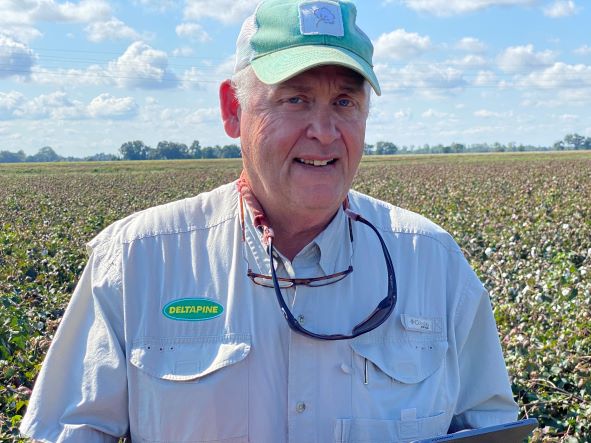Deltapine Maintaining Strength While Building for the Future
USDA may have given up on its Cotton Varieties Planted report after 2020. Yet it’s a reasonable assumption that Deltapine varieties continued to take the lion’s share of U.S. cotton acres this year – a year that Keylon Gholston says has been “one of the most unusual years I’ve seen in my years in the business.”
“It’s been extremes one way or the other no matter where you go across the Cotton Belt,” says Gholston, Deltapine Cotton Product Manager, “One thing’s for sure – this year you’re going to be able to see varieties that can handle extremes from an environmental standpoint and still yield.”
Heading into the new year, Deltapine brought two new Class of ’21 varieties to market. Gholston is pretty pleased with their performance.
“DP 2115 B3XF is a really early season variety, a little more determinate than DP 2012 B3XF,” he states. “Where we’ve seen it on good land with good management this year, it looks outstanding. It seemed to fruit a bit earlier than most other varieties did this year, and I think it has really high yield potential. I’m excited to get the yield data back after harvest.”
Gholston also had high praise for DP 2127 B3XF.
“It could be one of the strongest yielders to come out of the New Product Evaluator (NPE) program, and that’s saying a lot,” he says. “It looks strong pretty much everywhere in the Mid-South, Southeast, and parts of East Texas. That variety is going to have some outstanding yields, coupled with really good fiber quality.”
As far as other Deltapine varieties showing good performance this year, Gholston offered a quick evaluation:
- “DP 2012 B3XF is an early season variety with a lot of indeterminacy that looks good pretty much across the Belt. That’s going to help this variety this year with the environment that we’ve had.”
- “DP 2020 B3XF is easy to manage from a PGR standpoint and looks good across the Belt.”
- “DP 2038 B3XF is going to have an outstanding year in the Mid-South, especially if it gets the weather it needs to open the top bolls.”
- “DP 2055 B3XF is a full season variety that looks extremely good in the Southeast and South Delta this year.”
And Gholston still saves a special mention for DP 1646 B2XF – introduced as part of the Class of ’16 and still going strong. “It’s still a very dependable, high yielding, high fiber quality variety that fits across the Cotton Belt.”
Looking ahead, Gholston is impressed with three new B3XF varieties that have shown promise in different parts of the Cotton Belt in the 2021 NPE on-farm evaluation program, as well as three other varieties specially bred and targeted for West Texas.
“We’re coming with some promising varieties that fit the West Texas tough acre environment where they have light water or total dryland,” he says. “It’s a totally new set of germplasm – a more determinate type of varieties with a shorter plant structure.”
Regulatory issues have temporarily paused market introduction of new B3TXF varieties featuring the ThryvOn Insect Technology for 2022. Yet Gholston likes what he’s seen and believes growers will be, too.
“What we’re seeing in field trials is about two weeks’ difference in maturity between B3TXF and B3XF and B2XF,” he notes. “I attribute it to the fact that the cotton didn’t get delayed by thrips damage at a time when weather kept growers out of the field for timely thrips treatment.
“If the yield is there, there’s going to be a lot of pent-up demand for that technology.”
Saying So Long, but Not Goodbye
In some circles, Keylon Gholston is known as the Father of the NPE Program. To others in the industry, he’s the face of Deltapine, checking field after field in state after state for nearly 30 years. You’d be hard pressed to find someone in the cotton business that doesn’t know him.
Gholston is retiring at the end of December. He says it’s time to go home to see if he can be a fair cotton farmer instead of a poor one.
“I’ve been in the ag business all my life,” he recalls. “I grew up on a farm. Dad had a farm supply business, so I grew up in that as well as the ginning business for a few years.”
After graduating from Mississippi State (“barely,” he says), Keylon joined MFC Services, leading to a career with some of the legendary names in the cotton seed business through moves and acquisitions – Sandoz, McNair, Coker, Paymaster, Delta & Pine Land, Monsanto, and now Bayer.
“I feel like I’ve been doing the same thing,” he laughs. “I just worked for a lot of different companies while I was doing it.”
He’s also seen a lot of change – all for the better. Boll Weevil Eradication. Bollgard. Roundup Ready Cotton. He’s been part of it all.
“The whole industry has changed,” he says. “I don’t know of anything that I could have done to have more fun. To me, the thing that sets the cotton industry apart is the tightness and friendship. It’s almost like being in a big family. Everybody within the cotton industry pulls together for the good of the whole industry. I don’t think many industries can say that.”
Eric Best will step into some big shoes, with Keylon’s substantial blessing. “Eric has a great agronomic background in cotton,” he says. “He’s going to do great.”










